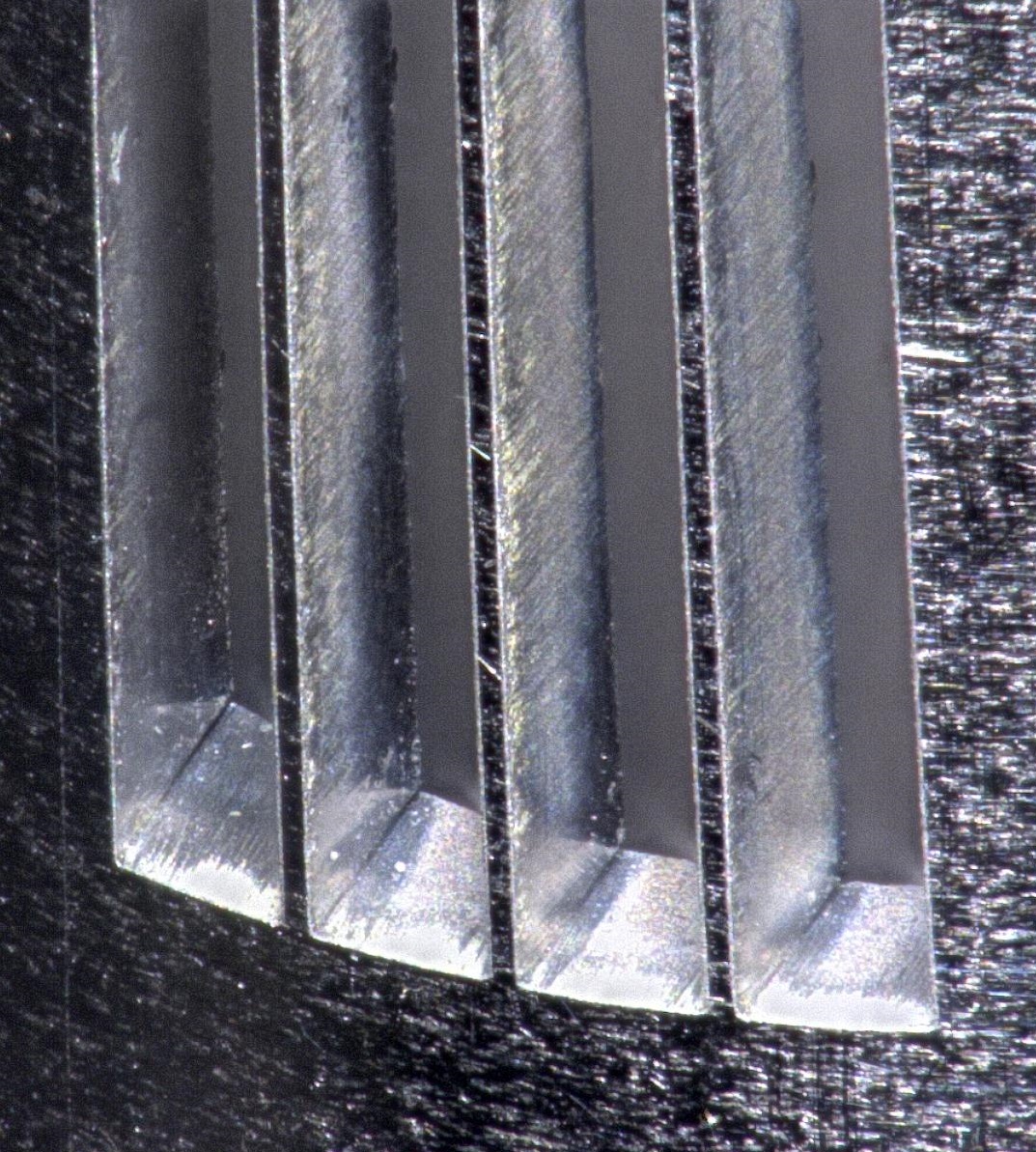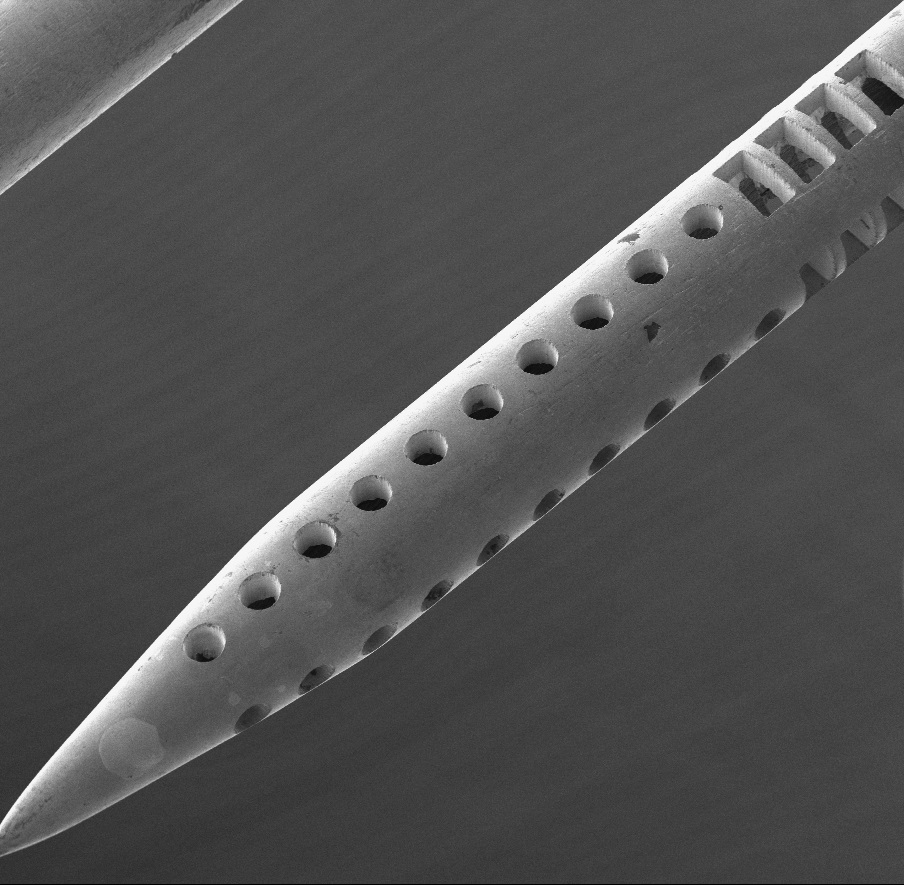
Laser technology was developed in the mid-20th century, and over the decades has emerged as a leading processing method for a broad range of applications. One of the newest uses is for high precision laser micromachining.
Micromachining is a tightly controlled material removal process in which a laser beam is used under highly controlled conditions to reshape a material. For decades, the creation of small drill-holes, narrow pockets and slots, and intricately shaped features has been produced using mechanical milling, chemical etching, or EDM processes. However, progressive miniaturization and heightened quality requirements have fueled the need for improved processing techniques that can produce smaller features with fewer defects. Laser micromachining has answered this need.
As a remote photonic processing technique that imparts no mechanical force on a material surface, laser micromachining is ideal for creating intricate, tight-tolerance features in small, delicate parts. Processes can be tightly optimized and remain repeatable in high production without the need to sharpen a drill bit, repair a broken blade, or change a worn-out photomask.
Laser micromachining applications
 Applications for laser micromachining are broad. The medical device, aerospace, semiconductor and displays, and energy and renewables industries already rely on laser micromachining for many of the smallest and most delicate processes. Every day, new applications are developed that further showcase the unique capabilities of laser micromachining.
Applications for laser micromachining are broad. The medical device, aerospace, semiconductor and displays, and energy and renewables industries already rely on laser micromachining for many of the smallest and most delicate processes. Every day, new applications are developed that further showcase the unique capabilities of laser micromachining.
One of the fastest growing markets for laser micromachining is the medical device industry. Advancements in minimally invasive surgical techniques and drug delivery capabilities continually drive the need for smaller and more precise components.
One of the most common devices in the medical device field is the catheter. Small features, like ports, slots, and grooves, often below 50µm in size, need to be machined into these devices to facilitate their use. The features must be extremely precise, with tolerances as small as ±2.5µm, and there is little room for defects or imperfections. Traditional methods like mechanical milling can leave burrs on the parts, and many of these features are simply too small for mechanical tools. Laser beams, on the other hand, can be focused to extremely small diameters, and since they are pure light, there is no chance for broken or worn tools that can cause inconsistent results.
One of the most exciting advancements in laser technology in recent years has been the refinement of the ultrashort pulse, or USP, laser for everyday industrial use. Traditional, older generation cutting lasers emit continuous wave energy, similar to turning on a flashlight, or pulses that last for milliseconds or microseconds. When laser light interacts with a surface for these long-time durations, it drives excessive heat conduction and melt expulsion that result in unwanted defects, like burrs, dross, and material embrittlement. Modern USP lasers, on the other hand, emit extremely short pulses that may be only a few hundred femtoseconds in duration. Each laser pulse’s interaction with the material terminates before significant thermal conduction begins to occur, allowing for nearly athermal ablation from the processing surface. The results are highly repeatable features with ablation resolution as small as ±1µm and excellent finish quality – no burrs, no dross, and dramatically reduced heat-affected zones. The multiple wavelength options available with USP lasers mean that almost all materials can be processed.
Laser micromachining promises improvements for modern high-precision processing methods, as well as opportunities for new applications altogether. With the advent of industrially viable ultrashort pulse lasers, laser system integrators and machine builders are now able to offer systems that can provide clean, defect-free parts right after the laser process, often removing the need for secondary post-processing.
Excerpted from a paper by Hojin Jang, principal engineer, Diksha Maheshwari, R&D laser applications engineer, and Brennan DeCesar, manager, Amada Weld Tech Inc.
For more information on Amada Weld Tech Inc., phone 626-303-5676 or visit https://amadaweldtech.com.
Contact Details
Related Glossary Terms
- electrical-discharge machining ( EDM)
electrical-discharge machining ( EDM)
Process that vaporizes conductive materials by controlled application of pulsed electrical current that flows between a workpiece and electrode (tool) in a dielectric fluid. Permits machining shapes to tight accuracies without the internal stresses conventional machining often generates. Useful in diemaking.
- embrittlement
embrittlement
Reduction in the normal ductility of a metal due to a physical or chemical change. Examples include blue brittleness, hydrogen embrittlement and temper brittleness.
- gang cutting ( milling)
gang cutting ( milling)
Machining with several cutters mounted on a single arbor, generally for simultaneous cutting.
- milling
milling
Machining operation in which metal or other material is removed by applying power to a rotating cutter. In vertical milling, the cutting tool is mounted vertically on the spindle. In horizontal milling, the cutting tool is mounted horizontally, either directly on the spindle or on an arbor. Horizontal milling is further broken down into conventional milling, where the cutter rotates opposite the direction of feed, or “up” into the workpiece; and climb milling, where the cutter rotates in the direction of feed, or “down” into the workpiece. Milling operations include plane or surface milling, endmilling, facemilling, angle milling, form milling and profiling.
- turning
turning
Workpiece is held in a chuck, mounted on a face plate or secured between centers and rotated while a cutting tool, normally a single-point tool, is fed into it along its periphery or across its end or face. Takes the form of straight turning (cutting along the periphery of the workpiece); taper turning (creating a taper); step turning (turning different-size diameters on the same work); chamfering (beveling an edge or shoulder); facing (cutting on an end); turning threads (usually external but can be internal); roughing (high-volume metal removal); and finishing (final light cuts). Performed on lathes, turning centers, chucking machines, automatic screw machines and similar machines.
